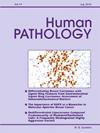Molecular profile of micropapillary urothelial carcinoma of the urinary bladder: An analysis of 99 cases by next-generation sequencing
IF 2.7
2区 医学
Q2 PATHOLOGY
引用次数: 0
Abstract
Micropapillary urothelial carcinoma (MPUC) is an aggressive neoplasm with distinct histology. We examined the molecular profile of MPUC and its relationship to patients' clinicopathologic features in 99 patients who underwent next-generation sequencing from 2010 to 2020 at a single institution. The patients included 77 men and 22 women with a mean age of 68 years (range, 24–91 years). Next-generation sequencing was performed on primary (n = 74) and metastatic (n = 25) tumor specimens. Somatic gene mutations were detected in 98 tumors, and the most common mutations were TP53 (n = 71), TERT (n = 49), ARID1A (n = 28), ERBB2 (n = 24), and RB1 (n = 22). Copy number variations were detected in 22 tumors, including ERBB2 (n = 8), CDK12 (n = 3), CCND1 (n = 3), and other genes (n = 8). No gene fusions or microsatellite instability was detected. Human epidermal growth factor receptor 2 (HER2) overexpression was detected more frequently in MPUCs with ERBB2 amplifications than those with ERBB2 mutations. Individual gene mutations did not significantly affect the overall survival, but patients with ERBB2 amplifications had a significantly shorter overall survival than those with ERBB2 mutations (p = 0.043). MPUC demonstrated distinct gene alterations in oncogenes and tumor suppressor genes that may be involved in MPUC's oncogenesis. ERBB2 gene amplifications were associated with HER2 overexpression in MPUC, which may contribute to MPUC's aggressive behavior.
99例膀胱微乳头状尿路上皮癌的分子特征分析
微乳头状尿路上皮癌(MPUC)是一种具有独特组织学特征的侵袭性肿瘤。我们研究了MPUC的分子特征及其与患者临床病理特征的关系,这些患者在2010年至2020年期间在一家机构接受了新一代测序。患者包括77名男性和22名女性,平均年龄68岁(范围24-91岁)。对原发(n = 74)和转移(n = 25)肿瘤标本进行新一代测序。98例肿瘤中检出体细胞基因突变,最常见的突变为TP53(71例)、TERT(49例)、ARID1A(28例)、ERBB2(24例)和RB1(22例)。在22个肿瘤中检测到拷贝数变异,包括ERBB2 (n = 8)、CDK12 (n = 3)、CCND1 (n = 3)和其他基因(n = 8)。未发现基因融合或微卫星不稳定性。人表皮生长因子受体2 (HER2)过表达在ERBB2扩增的MPUCs中比ERBB2突变的MPUCs中更常见。个体基因突变对总生存期无显著影响,但ERBB2扩增患者的总生存期明显短于ERBB2突变患者(p = 0.043)。MPUC在致癌基因和肿瘤抑制基因中表现出明显的基因改变,这可能与MPUC的肿瘤发生有关。ERBB2基因扩增与HER2在MPUC中的过表达有关,这可能与MPUC的攻击行为有关。
本文章由计算机程序翻译,如有差异,请以英文原文为准。
求助全文
约1分钟内获得全文
求助全文
来源期刊

Human pathology
医学-病理学
CiteScore
5.30
自引率
6.10%
发文量
206
审稿时长
21 days
期刊介绍:
Human Pathology is designed to bring information of clinicopathologic significance to human disease to the laboratory and clinical physician. It presents information drawn from morphologic and clinical laboratory studies with direct relevance to the understanding of human diseases. Papers published concern morphologic and clinicopathologic observations, reviews of diseases, analyses of problems in pathology, significant collections of case material and advances in concepts or techniques of value in the analysis and diagnosis of disease. Theoretical and experimental pathology and molecular biology pertinent to human disease are included. This critical journal is well illustrated with exceptional reproductions of photomicrographs and microscopic anatomy.
 求助内容:
求助内容: 应助结果提醒方式:
应助结果提醒方式:


